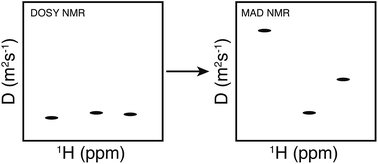Matrix-assisted diffusion-ordered spectroscopy
Abstract
Diffusion NMR is a potentially routine tool in the analysis of mixtures, from industrial and synthetic outputs to natural products. However, the technique struggles to resolve species of similar size. Matrix-assisted DOSY offers a flexible approach to resolving such ambiguities on the basis of the chemical structures involved and on their interactions with a larger co-solute or matrix. The use of chromatographic supports, surfactants and polymers, in particular, is illustrated. The resolution of a wide range of different analyte mixtures, on the basis of differences in chemical structure and in stereochemistry, is demonstrated.


 Please wait while we load your content...
Please wait while we load your content...